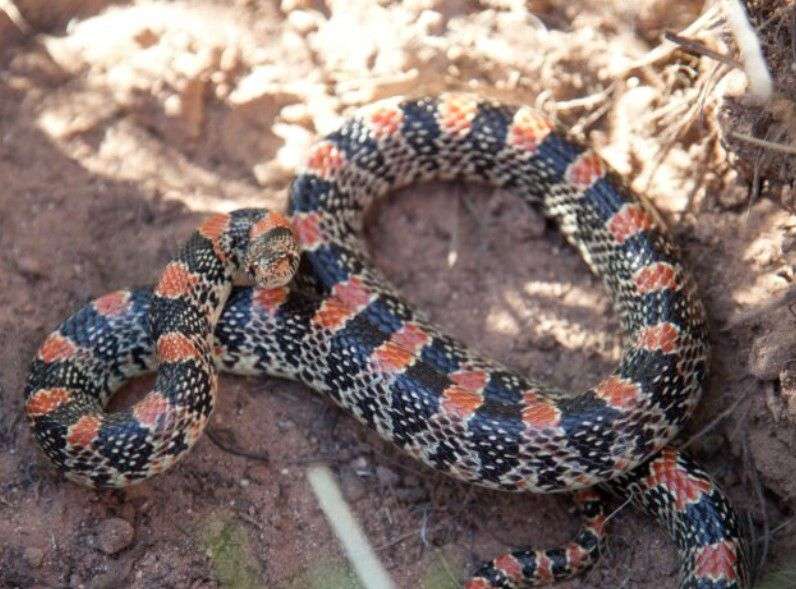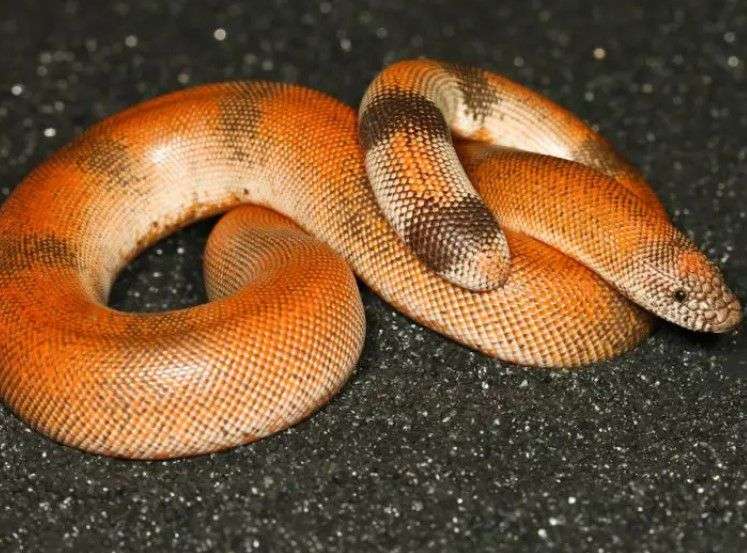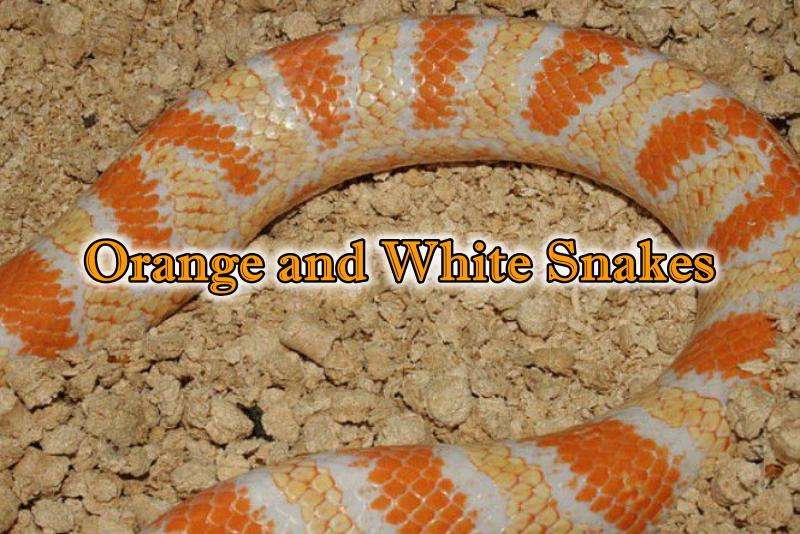Today, we have come up with a compelling article about 14 Orange and White snakes of the world. Orange and White Snakes are wild as well as domestic. These snakes, along with other dark colors, are present in categories of wild snakes as lighter colors make them distinguished and susceptible to danger.
The pure orange and white snakes are mostly bred for selling purposes and only occur naturally when they are well camouflaged with their surrounding environment.
No one can deny the beauty of these Orange and White snakes, and everyone is hypnotized by their beautiful bright colors, unique patterns, diversely alluring textures, and outlandish looks.
Discover 14 Orange and White snakes Worldwide
1) San Francisco Garter Snake
San Francisco Garter Snake is a nonvenomous snake and is claimed to be harmless to humans, but they produce mild venom, which can kill small prey. These snakes are often found in or near water sources. They cannot be easily located or captured because they are extremely shy creatures and flee to hidden covers or water to hide.
These snakes inhabit wetlands or densely vegetated ponds; they also like to live in forests with dense canopies, temporary ponds, or freshwater bodies and the zone between stream and pond habitat or bank sides.
Their diet consists of California red-legged frogs, juvenile American bullfrogs, and Pacific tree frogs, which they consume by grabbing and swallowing as a whole.
They were one of the first animals to be listed on the endangered species list when the endangered species act was passed in 1967.
These are slender multi-colored species that have a striped pattern and have alternating, longitudinal lines of orange, white, and black color. Some also have a whitish-blue color base. They’ve more enormous eyes compared to other subspecies of its group.
- Scientific name: Thamnophis sirtalis tetrataenia
- Size: 46–140 cm (18-55 inches)
- Location: San Mateo County and the extreme northern part of coastal Santa Cruz County in California
2) Texan Scarlet Snake
Texan Scarlet Snake was earlier considered to be a subspecies; it is now placed in the species coccinea. It has a grayish-white base with a red-to-orange gradient, distinguishing blotches encircled inside the black border.
Unlike the other species of its kind, the black borders do not join to complete the circle on the sides. Their diet consists of small rodents, lizards, the eggs of other turtles, and other snakes.
The scarlet snakes are excellent burrowers and hide beneath logs, under pine debris, or other organic litter. These are harmless creatures and seldom bite when attacked but release a foul-smelling odor.
- Scientific name: Cemophora coccinea (s.sp lineri)
- Size: 36–66 cm (14–26 inches)
- Location: Southern Texas, Gulf of Mexico
3) Long-nosed Snake

The Long-nosed snakes are named after their elongated, slightly upfront nose. They are nonvenomous snakes that belong to the group Colubridae.
They like to reside in deserts, grassland, shrubland, and savanna. It dwells in burrows most of the time and are nocturnal burrowing snakes.
Their diet consists of lizards, amphibians, small snakes, and rodents. Unlike other species, when these snakes face any danger, they twist their body and shake their tails to defecate, releasing a foul odor and releasing blood from the cloaca out of nervousness and fear.
These have alternating orangish-red and black saddling, which are present as alternate incomplete bands on the base of a yellow to the cream background. Their bellies are primarily white or cream-colored.
- Scientific name: Rhinocheilus lecontei
- Size: 22–40 inch
- Location: North America
4) Western Blackneck Garter Snake
The Western Blackneck Garter Snake is a large snake in comparison to the subspecies of its group. They have an orange to yellow color elongated line which runs from their neck down to the tail and a dark olive color band stripe on their sides. Their base and belly color is usually cream or white, with little hints of gray.
They are nonvenomous, therefore, usually harmless to humans or their predators, but their bite can cause inflammation, swelling, or itching.
These are water snakes that swim in the water and eat small fish and tadpoles as their meal; therefore, they dwell near rivers.
These snakes also feast upon amphibians, other snakes, and invertebrates such as earthworms.
They inhabit desert scrub, grasslands, chaparral, and woodland environments to maintain a minimum distance from water sources and can bask easily, too.
- Scientific name: Thamnophis cyrtopsis
- Size: 107 cm (42 inches)
- Location: Southeastern and Central Arizona, parts of the Southwestern United States, Mexico, and Guatemala
5) Western Terrestrial Garter Snake
Western Terrestrial Garter snakes occur in various habitats, including grasslands, woodlands, and coniferous forests. Although most are terrestrial, some semi-aquatic populations are also seen in the Great Basin and the Rocky Mountains.
These snakes have a beautiful pattern of white, orange, and black color. Three stripes of white or yellow color are present, one on the dorsal front and the other two on each side. They have black spots forming a line on their orange or red base.
Terrestrial populations’ primary food sources include slugs, salamanders, small mammals, and lizards. In contrast, inland populations’ diet consists of frog, toad larvae, leeches, and fish. They are mildly venomous snakes and don’t cause systematic symptoms in humans.
These snakes have a weaker, inefficient constriction in comparison to most of the snakes, but it’s the only garter snake that can constrict its prey to death. They take much longer time, and their hold is loose on their prey
- Scientific name: Thamnophis elegans
- Size: 46–104 cm (18–41 inches)
- Location: central British Columbia, central Alberta, southwestern Manitoba in Canada, western United States, Baja California, Mexico
6) Common Garter Snake
Common garter snakes can be visually identified by longitudinal stripes present, on the dorsal front and on the sides. They are available in a wide range of colors, including green, blue, yellow, gold, red, orange, brown, and black.
Its subspecies, T. s. pallidulus, has a dark orange base body with light yellow or white color stripes and black color circular spots arranged in lines.
These are venomous snakes and are resistant to naturally found toxins. They have the ability to absorb these toxins and become more poisonous, and can intimidate their potential prey. Their venom is very mild and causes little to no harm to humans but can result in minor symptoms.
They inhabit forests, fields, and prairies to streams, wetlands, meadows, marshes, and ponds, and it is often found near water.
Common garter snakes are very quick and can swiftly catch fish and tadpoles. Their diet also contains amphibians, earthworms, lizards, leeches, slugs, insects, snails, and crayfish.
- Scientific name: Thamnophis sirtalis
- Size: 4 ft (1.2 m)
- Location: North America
7) Indian Sand Boa

Indian Sand Boas are tubular in shape with a wedge-shaped head and a non-distinguishing tail that is just as thick as the rest of its body to confuse its predators. It has small eyes and a small shiny polished scale that ranges from reddish-brown to tan-yellow.
The orange color form has a luminous dark orange hue with darker distant patches that are somewhat diminished. It has blurry white color lines that are present on its sides.
Indian sand boas inhabit dry, semi-desert shrublands and rocky foothills. They prefer sandy soil because it has a brittle texture and can be easily burrowed.
There are many myths that are associated with these species like, they can bring good luck or can cure AIDS. This has resulted in the illegal trade of these species and made them endangered species.
Their meal consists of mammals and small rodents. Some also feed exclusively on other snakes. They are ovoviviparous; and can give birth to up to 14 young ones at a time.
- Scientific name: Eryx johnii
- Size: 61–91 cm (2–3 feet)
- Location: Iran, Pakistan, and India
8) Kenyan Sand Boa
Kenyan sand boas are massive and have tiny heads and small tails. They have really smooth scales, excluding the tail, which is bumpy. They have yellow to orange coloration, with black or dark brown color splotches present on the dorsal side. Ventrally, they are entirely white or cream.
The albino morphs have complete white skin with yellow to orange color patches present on the dorsal front.
They are a great choice as reptile pets because of their small body, docile nature, and minimum care requirements.
Kenyan sand boas inhabit semi-desert and scrub savannahs and rock outcroppings. It prefers sandy, crumbly soil because it spends most of its time in underground burrows. It also likes to climb trees occasionally.
They feast upon small mammals, lizards, and birds that are killed by constrictions. They also like to hunt out the nests of small mammals and birds infrequently.
- Scientific name: Eryx colubrinus
- Size: 30–60 cm (12–24 inches)
- Location: Northern and Eastern Africa
9) Milos Viper
Milos viper is a species of the family Vipers. It is listed in the IUCN list of endangered species. It is a venomous viper, and its venom is very dangerous and can be fatal in some cases.
However, they are not aggressive in nature but can become offensive if raided. They inhabit small valleys that convert into puddles when dried.
Their diet consists of lizards, mice, and birds. They patiently wait for the prey to get closer before striking them.
Milos viper have a dusty tan to light brown base and have dark orange color bands or patches throughout their body. They have an elongated body with a narrow tail and a triangular-shaped head.
- Scientific name: Macrovipera lebetina schweizeri
- Size: 50–70 cm (20–28 inches)
- Location: endemic to the Cyclades Archipelago in the Aegean sea
10) Rhinoceros Viper
Rhinoceros viper can be easily distinguished by the presence of a large, triangular head and two to three horn-like structures above its nostrils. They have an arrow shape mark on its head. They have massive bodies and strongly-keeled scales. These are venomous with long and hollow fangs.
Rhinoceros Viper has beautifully designed patterns of various colors, that includes blue, brown, and pink and is highlighted by yellow color lines. They have an orange color pattern on a white base.
- Scientific name: Bitis nasicornis
- Size: 72–107 cm (28–42 inches)
- Location: forests of West and Central Africa
11) Albino Western Hognose
Albino Western Hognose is a small-bodied, muscular snake and has variable patterns on its skin. Most specimens of this snake look like rattlesnakes, to the untrained eyes. They have a white to yellow colored base with bright orange color circular spots scattered throughout their body.
The primary reason for calling them Hognose is their hog-like look due to the upturned manner of their modified rostral scale.
This species is not dangerous to humans, but it can be harmful to its preferred wild food source, toads.
- Scientific name: Heterodon nasicus
- Size: 40–50 cm (15–20 inches)
- Location: North America
12) Albino Corn Snake
Albino corn snakes are also called panther snakes due to their appearance. They are spotted snakes. They have similar marking patterns as their normal counterparts.
Albino variants lack dark color, but some have red and orange color bands, patches, and oval shape marks from head to tail. They have lighter albino or cream color bases. These markings are present on the belly side, too, giving them a corn-kernel pattern.
Corn Snakes are nonvenomous snakes and subdue their prey by constricting them with its body and killing them. Their favorite food consists of kingsnakes, coral snakes, and rodents.
- Scientific name: Pantherophis guttatus
- Size: 61–182 cm ( 2–6 feet)
- Location: Southeastern and Central United States
13) Nelson’s Milk Snake
Nelson’s milk snake got its name from Edward W. Nelson in order to honor him. They are non-venomous subspecies of kingsnakes.
They are found near water sources, including one utilized for irrigation of agricultural processes. They inhabit Semi-arid coastal thorn scrub and interior tropical deciduous forests.
These snakes have a tolerance for other snakes’ venom, and therefore they feast on other snakes. Their diet also consists of birds, small rodents, lizards, and amphibians.
Nelson’s Milk Snake have 13 to 18 alternating patterns of red or orange color bands or rings, along with white, yellow, and black colors, too. They have 19 to 23 rows of smooth scales.
- Scientific name: Lampropeltis triangulum nelsoni
- Size: 110 cm (42 inches)
- Location: Mexico from southern Guanajuato and central Jalisco to the Pacific Coast, also found on the narrow plains of northwestern Michoacá, Tres Marias Islands
14) Albino Ringneck Snake
Albino Ringneck snake is a morph of ringneck snake, which has albinism; they lack pigments which make them colorful. They have a single orange color ring or color on their neck or nape, and their remaining body is completely albino white or cream in color.
Albino Ringneck Snake are best known for their unique defense posture of curling up their tails, but this feature is absent in albino morphs. They inhabit moist woodlands or rocky hills where cover or woody debris is accessible. Their venom is very mild and harmless, and they use it as a feeding strategy rather than defending.
- Scientific name: Diadophis punctatus
- Size: 25–38 cm (25–18 inches)
- Location: the United States, central Mexico, and southeastern Canada.
Conclusion:
Some Orange and White snakes are found in the wilderness, naturally with other colors, but, complete Orange and White morphs are only found in domestic households as pets and are bred for the sole purpose of selling and buying.
If any pure form occurs naturally because of albinism, then they’re found in the forests where good covers are present such as plant debris, foliage or animal matters.
Refrences: Wikipedia, Britannica, National geographic– snakes, facts and information.
Also Read:

Hey there! I’ve been the kid who used to love watching all the science stuff and that fascination lead me to choose Zoology as my Major in Graduation. I’m a self-taught writer and spend my time writing scintillating content on animals. I love observing animals behavior and their bond with humans. I want to give my point of view regarding animals i research about. I had done several projects on animals during my graduation and learned their behavior thoroughly.

Comments are closed.